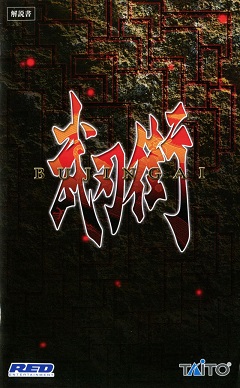 \\
\\Bujingai: The Forsaken City
When spectacle fighters stepped onto the scene, they brought something new to the table. For the longest time, games were all about dispatching of enemies as quickly as possible. These new games, though, put a lot of emphasis on doing so with style. Lots of style. Taito’s Bujingai: The Forsaken City on the PlayStation 2 was an early example of such a game. Players controlled a character named Lau Wong and lead him through scores of demons, slashing them to pieces. The whole process was a glorious tempest of swirling and clashing swords rarely seen in video games at the time.Taking place in the 23rd century, most of humanity has been wiped out due to a terrible environmental accident. Those who survived discovered that they now had special abilities imbued on them by the Earth. During this time, Lau Wong, one such human, returns to Earth where he must fight his old friend, Rei Jenron. Rei has been possessed by evil and is now summoning demons to wreck havoc on the world. Lau doesn’t want this, leading to an inevitable battle between the former friends.
The game was actually made specifically to help celebrate Taito’s 50th anniversary in 2003. With that, the company didn’t hesitate to splurge on the game’s production. They brought a number of talented people from other industries to help with Bujingai. Cowboy Bebop’s character designer, Toshihiro Kawamoto, and Trigun’s scenario writer, Yousuke Kuroda were both enlisted. Taito’s in-house band at the time, Zuntata, did the music. Meanwhile, the game’s main character was actually made in the likeness of a popular singer in Japan, Gackt. So, the studio really wanted to ring in their anniversary with style.
Style really is a central pillar of Bujingai. At it’s core, it is modeled after Hong Kong kung fu films where people are constantly twirling and flying around. In these movies, fight scenes look more like beautiful dances than anything else, and the same can be said for Bujingai. Most attacks will see Lau twirling his swords around in wide arcs, while his body goes in fluid motions. He can briefly glide through the air, wall jump, use spells, and also run along the walls. It’s even possible to reflect attacks and magic if Lau’s defenses are up. Some of these are particularly spectacular, with his swords twirling majestically, absorbing magic, then reflecting it back at the caster.
The game does reward players for being stylish with a rank system at the end of each stage. It looks specifically at style, how fast one cleared the level, consecutive hits, damage take, and so forth. The criteria is arguably a lot more straightforward than some modern spectacle fighters in terms of what people need to do. If players aren’t satisfied with their score, it is possible to revisit a stage whenever they want and try again later as well.
Bujingai is reasonably challenging. Enemies aren’t terribly prone to swarming the player, and they all have very obvious tells when they are about to do a major attack. People just need to pay attention and not get greedy while fighting them. Bosses take a bit more work to deal with. They do have trickier mechanics to figure out, so players may need a few tries to defeat them. Thankfully, when continuing after losing to a boss, the game starts you right at the start of the fight again, so it doesn’t waste players’ time. The boss fights really are something to behold, though. The game goes out of its way to make them feel like grandiose, larger than life battles.
Given that the world is largely destroyed, a lot of the level design has a bleakness to it. There are dilapidated buildings, misty forbidden forests, and ancient temples. However, given that the only humans who are still alive basically have magic, there are a number of places that feel mystical as well. There is a temple floating amidst the clouds, players will fight a dragon in space, and at do battle on the moon. Bujingai slowly ramps up the settings where Lau fights, starting in relatively mundane cities, then before one knows it, they’re in whimsical far off lands.
Monster and character designs are where the game really shines. There are legions of demons that players will need to fight and the game tries to make sure there is a decent variety with them. As mentioned earlier, though, bosses are where Bujingai really shines. These things are often quite big and imposing figures with attacks meant to look extremely powerful. Of course, boss fights should feel like a really big, important showdown. Taito seems to have gone that extra mile in driving this home. Lau himself is also quite impressive. His garb would be perfect in a Kung fu film and his likeness to Gackt is very good. Where Lau really shines is his animations, as they all look beautiful while he twirls around slashing demons.
When it comes to beautifully choreographed fights on the PS2, games like Devil May Cry tend to get the most attention. It’s a great game to be sure, but there are other spectacle fighters on the system worth gamers’ time. Bujingai is one such example. Combat is fluid, boss fights are amazing, and the story is pretty over the top, making it an excellent entry into this niche genre.
- IroIro
May 16, 2019
Genre: Action
Developer: Red Entertainment / Taito
Publisher: Taito
Released: 2003



